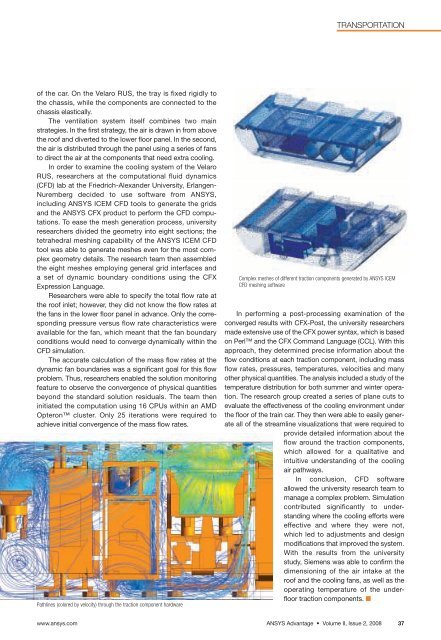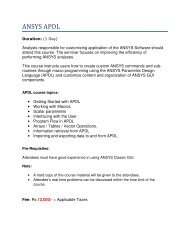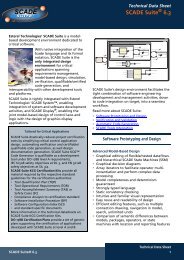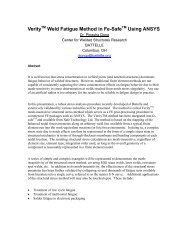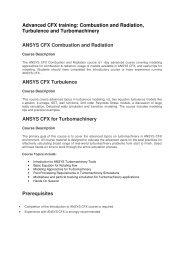Simulation - ANSYS
Simulation - ANSYS
Simulation - ANSYS
You also want an ePaper? Increase the reach of your titles
YUMPU automatically turns print PDFs into web optimized ePapers that Google loves.
of the car. On the Velaro RUS, the tray is fixed rigidly to<br />
the chassis, while the components are connected to the<br />
chassis elastically.<br />
The ventilation system itself combines two main<br />
strategies. In the first strategy, the air is drawn in from above<br />
the roof and diverted to the lower floor panel. In the second,<br />
the air is distributed through the panel using a series of fans<br />
to direct the air at the components that need extra cooling.<br />
In order to examine the cooling system of the Velaro<br />
RUS, researchers at the computational fluid dynamics<br />
(CFD) lab at the Friedrich-Alexander University, Erlangen-<br />
Nuremberg decided to use software from <strong>ANSYS</strong>,<br />
including <strong>ANSYS</strong> ICEM CFD tools to generate the grids<br />
and the <strong>ANSYS</strong> CFX product to perform the CFD computations.<br />
To ease the mesh generation process, university<br />
researchers divided the geometry into eight sections; the<br />
tetrahedral meshing capability of the <strong>ANSYS</strong> ICEM CFD<br />
tool was able to generate meshes even for the most complex<br />
geometry details. The research team then assembled<br />
the eight meshes employing general grid interfaces and<br />
a set of dynamic boundary conditions using the CFX<br />
Expression Language.<br />
Researchers were able to specify the total flow rate at<br />
the roof inlet; however, they did not know the flow rates at<br />
the fans in the lower floor panel in advance. Only the corresponding<br />
pressure versus flow rate characteristics were<br />
available for the fan, which meant that the fan boundary<br />
conditions would need to converge dynamically within the<br />
CFD simulation.<br />
The accurate calculation of the mass flow rates at the<br />
dynamic fan boundaries was a significant goal for this flow<br />
problem. Thus, researchers enabled the solution monitoring<br />
feature to observe the convergence of physical quantities<br />
beyond the standard solution residuals. The team then<br />
initiated the computation using 16 CPUs within an AMD<br />
Opteron cluster. Only 25 iterations were required to<br />
achieve initial convergence of the mass flow rates.<br />
Pathlines (colored by velocity) through the traction component hardware<br />
TRANSPORTATION<br />
Complex meshes of different traction components generated by <strong>ANSYS</strong> ICEM<br />
CFD meshing software<br />
In performing a post-processing examination of the<br />
converged results with CFX-Post, the university researchers<br />
made extensive use of the CFX power syntax, which is based<br />
on Perl and the CFX Command Language (CCL). With this<br />
approach, they determined precise information about the<br />
flow conditions at each traction component, including mass<br />
flow rates, pressures, temperatures, velocities and many<br />
other physical quantities. The analysis included a study of the<br />
temperature distribution for both summer and winter operation.<br />
The research group created a series of plane cuts to<br />
evaluate the effectiveness of the cooling environment under<br />
the floor of the train car. They then were able to easily generate<br />
all of the streamline visualizations that were required to<br />
provide detailed information about the<br />
flow around the traction components,<br />
which allowed for a qualitative and<br />
intuitive understanding of the cooling<br />
air pathways.<br />
In conclusion, CFD software<br />
allowed the university research team to<br />
manage a complex problem. <strong>Simulation</strong><br />
contributed significantly to understanding<br />
where the cooling efforts were<br />
effective and where they were not,<br />
which led to adjustments and design<br />
modifications that improved the system.<br />
With the results from the university<br />
study, Siemens was able to confirm the<br />
dimensioning of the air intake at the<br />
roof and the cooling fans, as well as the<br />
operating temperature of the underfloor<br />
traction components. ■<br />
www.ansys.com <strong>ANSYS</strong> Advantage • Volume II, Issue 2, 2008 37


